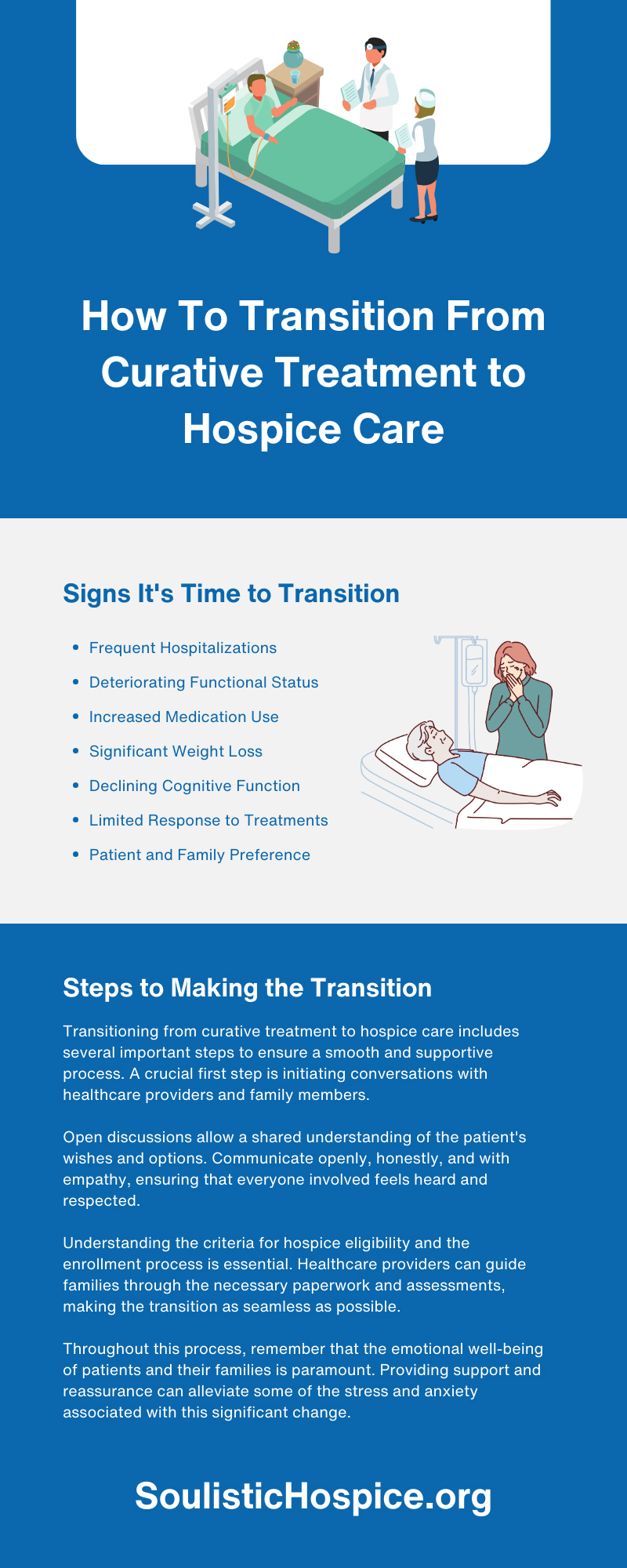
In the delicate realm of end-of-life care, hospice care offers a beacon of comfort and support for patients and their families. It represents a profound shift from curative to palliative care, focusing on quality of life rather than the pursuit of a cure.
Understanding this transition is crucial for caregivers and families navigating the emotional and logistical challenges that accompany terminal illness. This guide is designed to demystify hospice care, exploring how to transition from curative treatment to hospice care.
Differences Between Curative Treatment and Hospice Care
Curative treatment and hospice care serve distinctly different purposes. Curative treatment focuses on curing or controlling a disease, often involving aggressive medical interventions, therapies, and procedures aimed at eradicating the illness. It prioritizes extending life and beating the disease against all odds.
In contrast, hospice care shifts the focus to palliative care, emphasizing the relief of symptoms and providing emotional, spiritual, and psychological support. The main goal is to enhance the quality of life and ensure comfort during the final stages, acknowledging the natural progression towards the end of life.
Understanding these differences is key for caregivers and families to make informed decisions. While curative treatment can be physically taxing and invasive, hospice care offers a more holistic approach. It addresses the patient's physical needs and provides comprehensive support to alleviate the emotional burdens of patients and their loved ones.
Understanding the Need for Transition
The transition from curative treatment to hospice care often arises during a terminal illness when curative measures no longer yield the desired results. Families and caregivers may face numerous challenges during this period, including emotional turmoil, uncertainty, and the weight of making difficult decisions.
Acknowledging the need for the transition to hospice care can be emotionally taxing. Caregivers may grapple with feelings of helplessness and grief, while families might experience conflicting emotions about letting go of curative efforts. Open communication, empathy, and support are vital during this phase, allowing everyone involved to come to terms with the reality of the situation and work towards a shared understanding of what lies ahead.
Signs It's Time to Transition
Recognizing the signs that your loved one needs to transition from curative treatment to hospice care is essential in making timely and compassionate decisions. We’ll take a closer look at some of these telltale signs.
Frequent Hospitalizations
An uptick in hospital visits or emergency room trips, coupled with shorter recovery periods, may signal the need for hospice care. This pattern often indicates that curative treatments are no longer effective, and a different approach is necessary.
Deteriorating Functional Status
Observe whether the patient experiences a decline in their ability to complete daily functions, such as bathing, dressing, or eating independently. A noticeable decrease in functional status may suggest the appropriateness of palliative care.
Increased Medication Use
When higher doses or more frequent administration of pain medications become necessary, it may be a sign that curative measures are losing their efficacy. Hospice care can provide specialized support to manage symptoms effectively.
Significant Weight Loss
Unintentional and ongoing weight loss, or a decreased appetite, often signifies a transition towards the end stages of an illness. Hospice care addresses nutritional needs while offering comfort and support.
Declining Cognitive Function
Increased confusion, disorientation, or memory loss can indicate that a shift from curative to comfort care might be beneficial. Hospice care provides specialized support to address cognitive changes.
Limited Response to Treatments
If traditional treatments cease to work effectively or side effects outweigh their benefits, continuing with curative approaches may no longer be appropriate. Hospice care offers a holistic approach to enhancing quality of life.
Patient and Family Preference
When the patient or their family prefers to shift the focus from prolonging life to enhancing its quality and comfort, hospice care becomes an invaluable choice.
Steps to Making the Transition
Transitioning from curative treatment to hospice care includes several important steps to ensure a smooth and supportive process. A crucial first step is initiating conversations with healthcare providers and family members.
Open discussions allow a shared understanding of the patient's wishes and options. Communicate openly, honestly, and with empathy, ensuring that everyone involved feels heard and respected.
Understanding the criteria for hospice eligibility and the enrollment process is essential. Healthcare providers can guide families through the necessary paperwork and assessments, making the transition as seamless as possible.
Throughout this process, remember that the emotional well-being of patients and their families is paramount. Providing support and reassurance can alleviate some of the stress and anxiety associated with this significant change.
Preparing for Hospice Care
Preparing for hospice care involves creating a comfortable and supportive environment for the patient, whether at home or in a hospice facility.
Consider the physical space and adjust it to accommodate the patient's needs. This may include arranging furniture for accessibility, ensuring a peaceful and calming atmosphere, and having necessary medical equipment readily available.
Legal and financial preparations are also important aspects of preparing for hospice care. Discussing and documenting the patient's wishes regarding medical decisions, advanced directives, and power of attorney can provide peace of mind for the patient and their loved ones.
What to Expect in Hospice
Hospice care includes a multitude of services that address patients' and their families' medical, emotional, and spiritual needs.
Medical support in hospice care focuses on managing symptoms, providing pain relief, and ensuring the patient's comfort. Hospice care teams often include doctors, nurses, social workers, and chaplains collaborating to deliver comprehensive care.
Hospice care provides emotional and spiritual support during this challenging time. Counseling, chaplaincy services, and support groups offer comfort and help guide patients and their families through the emotional toll of end-of-life care.
Caregivers are crucial in hospice care, offering companionship, assistance with daily activities, and emotional support. Hospice care teams provide education and resources to empower caregivers in their vital role.
Coping Strategies and Support
Coping strategies and avenues of support are essential for families managing the emotional and physical demands of end-of-life care.
Connecting with support groups or counseling services can provide a safe space for families to share their experiences, gain insights, and receive guidance from others who understand their challenges.
Practicing self-care is equally important for caregivers and family members. Taking time for rest, engaging in activities that bring joy, and seeking respite care can help prevent burnout and maintain overall well-being.
Remember that hospice care teams are there to support patients and their families. Don't hesitate to ask for assistance or guidance whenever needed.
Navigate the Journey with Soulistic Hospice
In the final stages of life, hospice care is a beacon of compassion, dignity, and support. Hospice empowers families to cherish precious moments and create lasting memories by focusing on quality of life and providing holistic care.
Open discussions with healthcare providers and families are crucial in ensuring that end-of-life care wishes are respected and honored. By learning how to transition from curative treatment to hospice, families can make this decision with empathy and understanding.
Contact Soulistic Hospice today to learn about our end-of-life care plans if you're seeking personalized guidance and support. Our experienced team can help create a plan tailored to your unique needs and preferences.









